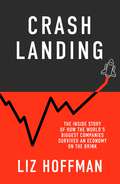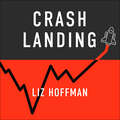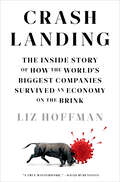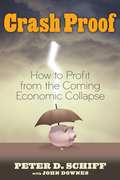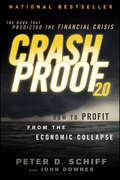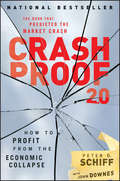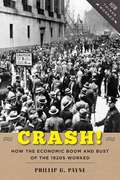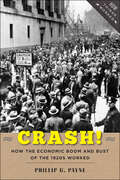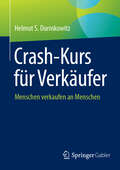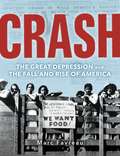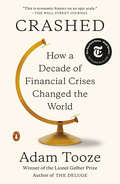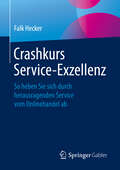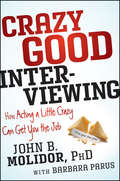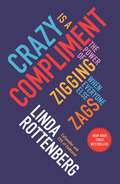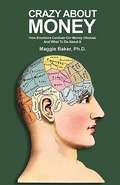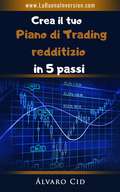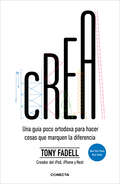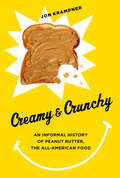- Table View
- List View
Crash Course: The American Automobile Industry's Road from Glory to Disaster
by Paul IngrassiaWith an updated Afterword by the author.This is the epic saga of the American automobile industry's rise and demise, a compelling story of hubris, missed opportunities, and self-inflicted wounds that culminates with the president of the United States ushering two of Detroit's Big Three car companies--once proud symbols of prosperity--through bankruptcy. With unprecedented access, Pulitzer Prize winner Paul Ingrassia takes us from factory floors to small-town dealerships to Detroit's boardrooms to the White House. Ingrassia answers the big questions: Was Detroit's self-destruction inevitable? What were the key turning points? Why did Japanese automakers manage American workers better than the American companies themselves did? Complete with a new Afterword providing fresh insights into the continuing upheaval in the auto industry--the travails of Toyota, the revolving-door management and IPO at General Motors, the unexpected progress at Chrysler, and the Obama administration's stake in Detroit's recovery--Crash Course addresses a critical question: America bailed out GM, but who will bail out America?
Crash Course: The American Automobile Industry's Road to Bankruptcy and Bailout--and Beyond
by Paul IngrassiaWith an updated Afterword by the author. This is the epic saga of the American automobile industry's rise and demise, a compelling story of hubris, missed opportunities, and self-inflicted wounds that culminates with the president of the United States ushering two of Detroit's Big Three car companies--once proud symbols of prosperity--through bankruptcy. With unprecedented access, Pulitzer Prize winner Paul Ingrassia takes us from factory floors to small-town dealerships to Detroit's boardrooms to the White House. Ingrassia answers the big questions: Was Detroit's self-destruction inevitable? What were the key turning points? Why did Japanese automakers manage American workers better than the American companies themselves did? Complete with a new Afterword providing fresh insights into the continuing upheaval in the auto industry--the travails of Toyota, the revolving-door management and IPO at General Motors, the unexpected progress at Chrysler, and the Obama administration's stake in Detroit's recovery--Crash Course addresses a critical question: America bailed out GM, but who will bail out America?
Crash Landing: The Inside Story Of How The World's Biggest Companies Survived An Economy On The Brink
by Liz HoffmanIt was the ultimate test for CEOs, and almost none of them saw it coming.__________In early March 2020, with the Dow Jones flirting with 30,000, the world's biggest companies were riding an eleven-year economic high. By the end of the month, millions would be out of work, iconic firms were begging for bailouts, and countless small businesses were in freefall. Slick consulting teams and country-club connections were suddenly of little use: business leaders were fumbling in the dark, tossing out long-term strategy and making decisions on the fly-decisions, they hoped, that might just save them.In Crash Landing, award-winning business journalist Liz Hoffman shows how the pandemic set the economy on fire-but if you look closely, the tinder was already there.Based on astonishing access inside some of the world's biggest and most iconic companies, this is a gripping account of the most remarkable period in modern economic history, revealing how they battled against an economic catastrophe for which there was no playbook: among them, AirBnB's Brian Chesky, blindsided by a virus in the middle of a high-stakes effort to go public; American Airlines's Doug Parker, shuttling between K Street and the White House, determined to secure a multi-billion-dollar bailout; and Ford's Jim Hackett, as his assembly lines went from churning out cars to ventilators.Crash Landing reveals the fear, grit, and gambles of the pandemic economy, while probing its implications for the future of work, corporate leadership, and capitalism itself, asking: Will this remarkable time give rise to newfound resilience, or become just anothercostly mistake to be forgotten?__________A gripping account of the financial carnage of the pandemic, revealing the fear, grit, and gambles that drove the economy's winners and losers.
Crash Landing: The Inside Story Of How The World's Biggest Companies Survived An Economy On The Brink
by Liz HoffmanAn exposé of the billionaires who built the US economy on sand, and the virus that saw it crumble.A kaleidoscopic account of the financial carnage of the pandemic, revealing the fear, grit, and gambles that drove the economy's winners and losers-from a leading Wall Street Journal reporter.Crash Landing takes readers behind the scenes of an unprecedented period of global economic turmoil, letting readers into the inner lives of the men and women trying to save big business from the brink.The world's most powerful CEOs never saw it coming, especially after a decade of growth that saw them riding high. Then whispers of a new flu-like illness became a crescendo, and by the end of March 2020 ten million people were out of work, iconic firms were begging for bailouts, and countless small businesses were in freefall.How do you sustain a workforce that can no longer work? How do you ride out a crisis that has no end in sight? How do you prepare for a recovery in a new world? Liz Hoffman pulls back the curtain on the most violent few months in the modern global economy, taking readers inside boardrooms, onto factory floors and into trading pits. Featuring original interviews with the people responsible for the economy, and in charge of making sure it survives. A gripping story of big business and even bigger characters, Crash Landing will appeal to fans of Michael Lewis and Andrew Sorkin. This is an audiobook that gives you the inside scoop, and answers the most important question of today: Will this remarkable time give rise to newfound resilience, or become just another costly mistake to be forgotten?(P) 2022 Hodder & Stoughton Limited
Crash Landing: The Inside Story of How the World's Biggest Companies Survived an Economy on the Brink
by Liz HoffmanA kaleidoscopic account of the financial carnage of the pandemic, revealing the fear, grit, and gambles that drove the economy&’s winners and losers—from a leading business reporter&“A true masterwork . . . perceptive, well researched, and captivating.&”—David M. Rubenstein, co-founder and co-chairman of The Carlyle Group, bestselling author of How to InvestIt was the ultimate test for CEOs, and almost none of them saw it coming. In early March 2020, with the Dow Jones flirting with 30,000, the world&’s biggest companies were riding an eleven-year economic high. By the end of the month, millions were out of work, iconic firms were begging for bailouts, and countless small businesses were in freefall. Slick consulting teams and country-club connections were suddenly of little use: Business leaders were fumbling in the dark, tossing out long-term strategy and making decisions on the fly—decisions that, they hoped, might just save them.In Crash Landing, award-winning business journalist Liz Hoffman shows how the pandemic set the economy on fire—but if you look closely, the tinder was already there. After the global financial crisis in 2008, corporate leaders embraced cheap debt and growth at all costs. Wages flatlined. Millions were pushed into the gig economy. Companies crammed workers into offices, and airlines did the same with planes. Wall Street cheered on this relentless march toward efficiency, overlooking the collateral damage and the risks sowed in the process.Based on astonishing access inside some of the world&’s biggest and most iconic companies, Crash Landing is a kaleidoscopic account of the most remarkable period in modern economic history, revealing—through gripping, fly-on-the-wall reporting—how CEOs battled an economic catastrophe for which there was no playbook: among them, Airbnb&’s Brian Chesky, blindsided by a virus in the middle of a high-stakes effort to go public; American Airlines&’ Doug Parker, shuttling between K Street and the White House, determined to secure a multibillion-dollar bailout; and Ford&’s Jim Hackett, as his assembly lines went from building cars to churning out ventilators.In the tradition of Too Big to Fail and The Big Short, Crash Landing exposes the fear, grit, and gambles behind the pandemic economy, while probing its implications for the future of work, corporate leadership, and capitalism itself, asking: Will this remarkable time give rise to newfound resilience, or become just another costly mistake to be forgotten?
Crash Proof
by John Downes Peter D. SchiffThe economic tipping point for the United States is no longer theoretical. It is a reality today. The country has gone from the world's largest creditor to its greatest debtor; the value of the dollar is sinking; domestic manufacturing is winding down - and these trends don't seem to be slowing. Peter Schiff casts a sharp, clear-sighted eye on these factors and explains what the possible effects may be and how investors can protect themselves. For more than a decade, Schiff has not only observed the U.S. economy, but also helped his clients reposition their portfolios to reflect his outlook. What he sees is a nation facing an economic storm brought on by growing federal, personal, and corporate debt, too-little savings, a declining dollar, and lack of domestic manufacturing. Crash-Proof is an informed and informative warning of a looming period marked by sizeable tax hikes, loss of retirement benefits, double digit inflation, even - as happened recently in Argentina - the possible collapse of the middle class. However, Schiff does have a survival plan that can provide the protection that readers will need in the coming years.
Crash Proof 2.0: How to Profit From the Economic Collapse
by Peter D. SchiffA fully updated follow-up to Peter Schiff's bestselling financial survival guide-Crash Proof, which described the economy as a house of cards on the verge of collapse, with over 80 pages of new material The economic and monetary disaster which seasoned prognosticator Peter Schiff predicted is no longer hypothetical-it is here today. And nobody understands what to do in this situation better than the man who saw it coming. For more than a decade, Schiff has not only observed the economy, but also helped his clients restructure their portfolios to reflect his outlook. What he sees today is a nation facing an economic storm brought on by growing federal, personal, and corporate debt; too little savings; and a declining dollar. Crash Proof 2.0 picks up right where the first edition-a bestselling book that predicted the current market mayhem-left off. This timely guide takes into account the dramatic economic shifts that are reshaping the world and provides you with the insights and information to navigate the dangerous terrain. Throughout the book, Schiff explains the factors that will affect your future financial stability and offers a specific three step plan to battle the current economic downturn. Discusses the measures you can take to protect yourself-as well as profit-during these difficult times Offers an insightful examination of the structural weaknesses underlying the economic meltdown Outlines a plan that will allow you to preserve wealth and protect the purchasing power of your savings Filled with in-depth insights and expert advice, Crash Proof 2.0 will help you survive and thrive during the coming years of economic uncertainty.
Crash Proof 2.0: How to Profit From the Economic Collapse
by Peter D. SchiffA fully updated follow-up to Peter Schiff's bestselling financial survival guide-Crash Proof, which described the economy as a house of cards on the verge of collapse, with over 80 pages of new material The economic and monetary disaster which seasoned prognosticator Peter Schiff predicted is no longer hypothetical-it is here today. And nobody understands what to do in this situation better than the man who saw it coming. For more than a decade, Schiff has not only observed the economy, but also helped his clients restructure their portfolios to reflect his outlook. What he sees today is a nation facing an economic storm brought on by growing federal, personal, and corporate debt; too little savings; and a declining dollar. Crash Proof 2.0 picks up right where the first edition-a bestselling book that predicted the current market mayhem-left off. This timely guide takes into account the dramatic economic shifts that are reshaping the world and provides you with the insights and information to navigate the dangerous terrain. Throughout the book, Schiff explains the factors that will affect your future financial stability and offers a specific three step plan to battle the current economic downturn. Discusses the measures you can take to protect yourself-as well as profit-during these difficult times Offers an insightful examination of the structural weaknesses underlying the economic meltdown Outlines a plan that will allow you to preserve wealth and protect the purchasing power of your savings Filled with in-depth insights and expert advice, Crash Proof 2.0 will help you survive and thrive during the coming years of economic uncertainty.
Crash! How The Economic Boom And Bust Of The 1920s Worked
by Phillip G. PayneSpeculation-an economic reality for centuries-is a hallmark of the modern U. S. economy. But how does speculation work? Is it really caused, as some insist, by popular delusions and the madness of crowds, or do failed regulations play a greater part? And why is it that investors never seem to learn the lessons of past speculative bubbles? Crash! explores these questions by examining the rise and fall of the American economy in the 1920s. Phillip G. Payne frames the story of the 1929 stock market crash within the booming New Era economy of the 1920s and the bust of the Great Depression. Taking into account the emotional drivers of the consumer market, he offers a clear, concise explanation of speculation's complex role in creating one of the greatest financial panics in U. S. history. Crash! explains how post-World War I changes in the global financial markets transformed the world economy, examines the role of boosters and politicians in promoting speculation, and describes in detail the disastrous aftermath of the 1929 panic. Payne's book will help students recognize the telltale signs of bubbles and busts, so that they may become savvier consumers and investors.
Crash!: How the Economic Boom and Bust of the 1920s Worked (How Things Worked)
by Phillip G. PayneThe irrationally exuberant highs and lows of the 1920s can help students recognize boom and bust cycles past, present, and future.Speculation—an economic reality for centuries—is a hallmark of the modern U.S. economy. But how does speculation work? Is it really caused, as some insist, by popular delusions and the madness of crowds, or do failed regulations play a greater part? And why is it that investors never seem to learn the lessons of past speculative bubbles? Crash! explores these questions by examining the rise and fall of the American economy in the 1920s.Phillip G. Payne frames the story of the 1929 stock market crash within the booming New Era economy of the 1920s and the bust of the Great Depression. Taking into account the emotional drivers of the consumer market, he offers a clear, concise explanation of speculation's complex role in creating one of the greatest financial panics in U. S. history.Crash! explains how postWorld War I changes in the global financial markets transformed the world economy, examines the role of boosters and politicians in promoting speculation, and describes in detail the disastrous aftermath of the 1929 panic. Payne's book will help students recognize the telltale signs of bubbles and busts, so that they may become savvier consumers and investors.
Crash-Kurs für Verkäufer: Menschen verkaufen an Menschen
by Helmut S. DurinkowitzIn diesem Buch erfahren Sie die einfachen, aber wirkungsvollen Strategien und Techniken, mit denen Top-Verkäufer zuverlässig erfolgreiche Abschlüsse erzielen. Mit einem klaren, systematischen Ansatz erläutert der Autor die wichtigsten Verkaufsphasen – von der Akquisition bis zum Abschluss. Die vermittelten Methoden sind so konzipiert, dass sie von jedem Verkäufer leicht angewendet und wiederholt werden können. Eine unverzichtbare Lektüre für alle, die im Verkauf tätig sind und langfristig erfolgreich sein wollen! Mit wertvollen Tipps für alle Arten der Neukundenakquise, das Verhalten am Messestand und anderen Verkaufswerkzeugen.
Crash: The Great Depression and the Fall and Rise of America
by Marc FavreauThe incredible true story of how real people weathered one of the most turbulent periods in American history—the Great Depression—and emerged triumphant. From the sweeping consequences of the stock market crash to the riveting stories of individuals and communities caught up in a real American dystopia, discover how the country we live in today was built in response to a time when people from all walks of life fell victim to poverty, insecurity, and fear. Meet fascinating historical characters like Herbert Hoover, Franklin Delano and Eleanor Roosevelt, Frances Perkins, Dorothea Lange, Walter White, and Mary McLeod Bethune. See what life was like for regular Americans as the country went from the highs of the Roaring Twenties to the lows of the Great Depression, before bouncing back again during World War II. Explore pivotal scenes such as the creation of the New Deal, life in the Dust Bowl, the sit-down strikes in Michigan, the Scottsboro case, and the rise of Father Coughlin. Packed with photographs and firsthand accounts, and written with a keen understanding of the upheaval of the 1930s, Crash shares the incredible story of how America survived—and, ultimately, thrived.
Crashed: How a Decade of Financial Crises Changed the World
by Adam ToozeFrom a prizewinning economic historian, an eye-opening reinterpretation of the 2008 economic crisis (and its ten-year aftermath) as a global event that directly led to the shockwaves being felt around the world today. <p><p> In September 2008 President George Bush could still describe the financial crisis as an incident local to Wall Street. In fact it was a dramatic caesura of global significance that spiraled around the world, from the financial markets of the UK and Europe to the factories and dockyards of Asia, the Middle East, and Latin America, forcing a rearrangement of global governance. In the United States and Europe, it caused a fundamental reconsideration of capitalist democracy, eventually leading to the war in the Ukraine, the chaos of Greece, Brexit, and Trump. <p> It was the greatest crisis to have struck Western societies since the end of the Cold War, but was it inevitable? And is it over? Crashed is a dramatic new narrative resting on original themes: the haphazard nature of economic development and the erratic path of debt around the world; the unseen way individual countries and regions are linked together in deeply unequal relationships through financial interdependence, investment, politics, and force; the ways the financial crisis interacted with the spectacular rise of social media, the crisis of middle-class America, the rise of China, and global struggles over fossil fuels. Finally, Tooze asks, given this history, what now are the prospects for a liberal, stable, and coherent world order?
Crashkurs Service-Exzellenz: So heben Sie sich durch herausragenden Service vom Onlinehandel ab
by Falk HeckerService-Exzellenz: Mit diesem Buch heben Sie sich von der Konkurrenz abIn diesem Buch über Service-Exzellenz erhalten Mitarbeiter in der Dienstleistungsbrache und im Verkauf wertvolle Tipps, wie sie trotz des zunehmenden Wettbewerbs durch den Onlinehandel dauerhaft Kunden für sich gewinnen können. Schließlich wird das Einkaufen im Internet immer anonymer und der persönliche Kundenkontakt seltener. Wenn jedoch Verkäufer und Kunde persönlich aufeinander treffen, ist das eine große Chance, sich mit herausragendem Service von Onlineanbietern abzugrenzen. Ware ist austauschbar – Menschen, die außergewöhnlichen Service bieten, dagegen nicht. Dieses Buch enthält eine Fülle von Beispielen, Tipps und praktischen Werkzeugen für Service-Exzellenz, mit denen Sie sich positiv vom Onlinehandel und von Mitbewerbern abheben. Hier erfahren Sie, wie Sie Ihr Auftreten verbessern, Mitarbeiter erfolgreich führen und motivieren und dadurch die Kundenzufriedenheit steigern, um letztendlich Ihre Vertriebsziele zu erreichen. So senden Sie die richtigen Signale Untergliedert in sechs Abschnitte erfahren Sie in diesem Buch zunächst mehr über die wichtige Rolle der Wertschätzung im Service. Lesen Sie, was eine gute Begrüßung ausmacht und wie Sie bei einer neuen Begegnung schnell die Sympathien potenzieller Kunden für sich gewinnen. Die folgenden Kapitel bringen Ihnen außerdem noch diese Serviceaspekte näher:Fragetechnik: Wer fragt, der führtKörpersprache: Die nonverbalen BotschaftenEinstellung: Wahre Motivation kommt von InnenVertrauen: Die größte Ehre, die wir dem Kunden antun könnenAutorität: Service braucht AugenhöheEntscheiden: Weniger ist häufig mehrTransparenz: Bewertungen sind das A & O im digitalen ZeitalterVerkaufen ist ein komplexer VorgangWie der Inhalt dieses Buchs zeigt, ist Service-Exzellenz nicht nur ein reiner Verkaufsprozess. Vielmehr geht es um zwischenmenschliche Handlungen, die sich zeitgleich auf einer psychologischen, soziologischen und philosophischen Ebene abspielen. Daher ist dieses Werk für alle Beschäftigten in Handels- oder Dienstleistungsunternehmen eine echte Empfehlung, um Kundenbindung und -begeisterung im Verkauf nachhaltig zu sichern.
Cravia: Launching High Growth Ventures in the Middle East
by Michael Norris Lynda M. ApplegateWalid Hajj (HBS '95), CEO of Dubai-based restaurant franchising company Cravia considers how best to expand his business in the fast-growing Gulf region. Should he add more American brands, expand to nearby countries, or open more of his current lineup of restaurants?
Cravia: Launching High Growth Ventures in the Middle East
by Michael Norris Lynda M. ApplegateWalid Hajj (HBS '95), CEO of Dubai-based restaurant franchising company Cravia considers how best to expand his business in the fast-growing Gulf region. Should he add more American brands, expand to nearby countries, or open more of his current lineup of restaurants?
Crazy Good Interviewing: How Acting A Little Crazy Can Get You The Job
by John B. MolidorHow acting a little crazy and thinking outside of the box can get you the job you want Ever hear of a job candidate stretching out on the interviewer's floor to fill out an application? Or an applicant who sees nothing wrong with texting during the interview? Securing a job interview is a golden opportunity. The crazy-bad behavior described above will not net a job offer. Crazy Good Interviewing shows readers that crazy-good behavior, however, can make an applicant stand out favorably in a sea of mediocrity. Take the candidate who created a keynote presentation on his iPad to show what he could bring to the job or the one who created a DVD highlighting her abilities. Crazy Good Interviewing is a book geared toward those who are looking for work in this tough economy. Addresses how slightly eccentric behaviors can tip the scales in the applicant's favor Delves into how to access your three key strengths, how to use body language effectively, how to prepare a five-sentence history that builds a bridge to the interviewer, and more Turn just plain crazy into crazy-good, and land the job at your next interview.
Crazy Is a Compliment
by Linda Rottenberg"If people aren't calling you crazy, you aren't thinking big enough." These days taking chances isn't just for college dropouts in hoodies. Whether you work at a Fortune 500 company, a nonprofit, or a mom-and-pop, everybody needs to think and act like an entrepreneur. We all need to be nimble, adaptive, daring--and maybe even a little crazy--or risk being left behind. But how do you take smart risks without risking it all? That's Linda Rottenberg's expertise. As the cofounder and CEO of Endeavor, the world's leading organization dedicated to supporting fast-growing entrepreneurs, she's spent the last two decades helping innovators think bold and execute smart. Now Rottenberg draws on her unrivaled experience to show you the proven techniques to achieve your dreams: from overcoming fear to facing down critics, from stalking supporters to exploiting chaos. Crazy Is a Compliment combines inspiring stories, original research, and practical advice to create a road map for getting started and going bigger. Rottenberg brings to life iconic entrepreneurs like Walt Disney and Estée Lauder and reveals how companies like MTV, GE, and Burberry found their best successes by breaking the corporate mold and embracing the entrepreneur mind-set. She also introduces us to some of the one thousand entrepreneurs she's advised, like Leila Velez, who started a hair-care company in her kitchen sink in Rio that now earns $80 million a year. As Linda writes: Every day I meet people with a dream. Maybe you're serving coffee and fantasizing about launching a microbrewery; maybe you've skipped college and yearn to start your own design firm; maybe you're sitting in your cubicle and brainstorming a new idea that can improve your company. You have a dream, but you don't know how to turn your dream into reality. Or you've already launched your dream but you're unsure how to take it to the next level. This book can show you the way.
Crazy about Money: How Emotions Confuse Our Money Choices and What to Do about It
by Maggie BakerThe book discusses what money means to us, where our beliefs come from, and how we develop money behavior from childhood through young adulthood and into our older years and focuses on how we use money--be it investing, borrowing, gambling, or leaving a legacy. Baker presents the stories of people she has worked with. By absorbing the stories' lessons, doing the exercises, and applying what you have learned to your own money situation, you will know how to make better money choices for yourself.
Crea il tuo piano di Trading redditizio in 5 passi
by Álvaro CidA molte persone piacerebbe poter investire in borsa e guadagnare denaro fino al punto di vivere solo di questo. Ma hanno un piccolo problema: non sanno come fare. Alcune persone hanno anche iniziato a investire in borsa con scarsi risultati. A questo punto la maggioranza abbandona e si convince che investire sia una cosa molto rischiosa per chiunque. Tristemente la maggioranza non otterrà il rendimento che si aspettava dal mercato. La presente guida ti aiuterà a creare il tuo metodo o il tuo piano di trading specifico. Ho progettato questi passi dopo anni di tentativi ed errori sul mercato e sulla mia metodologia di investimento; in questo modo potrai ottenere i risultati positivi che desideri dal mercato se segui questi semplici passi. Potrai creare un piano di Trading con questo metodo se: Sei un trader navigato che conosce le regole di entrata e di uscita dal mercato e vuoi inserire tutto in un metodo solido e redditizio. Sei un trader novizio agli inizi e hai bisogno di imparare i passi corretti fin dal primo momento. Hai voglia di guadagnare denaro sul mercato in modo professionale.
Crea: Una guía poco ortodoxa para hacer cosas que marquen la diferencia
by Tony Fadell«He colaborado en cambiar el mundo dos veces: con el iPod y con el iPhone. Ahora quiero la oportunidad de hacerlo por tercera vez» - TONY FADELL Una guía poco ortodoxa para crear innovaciones que marquen la diferencia, de mano del padre del iPod y el iPhone. Tony Fadell es un mito de la innovación y comparte en estas páginas su experiencia y su aprendizaje en algunas de las más destacadas compañías de los últimos treinta años, como Apple, Nest y Google, en el desarrollo de productos tecnológicos. En este libro, estructurado como una enciclopedia, recoge todo lo que ha aprendido: lecciones sobre liderazgo, innovación, pensamiento disruptivo, emprendimiento, éxito y fracaso, combinadas con historias personales de su carrera y de su trabajo con figuras de la talla de Steve Jobs o Larry Page. Un relato en primera persona de una época crucial, un retrato íntimo de algunos de los líderes más destacados de los últimos treinta años. Un legado para los genios del mañana. Reseñas:«Tony Fadell es uno de los grandes expertos mundiales en fundar compañías y crear productos increíblemente geniales. Este libro destila su sabiduría y aporta orientación en un conjunto de historias apasionantes».Walter Isaacson, autor y biógrafo de Steve Jobs, Albert Einstein y Leonardo da Vinci «Tony Fadell ha creado más cosas geniales que nadie en toda la historia de Silicon Valley, y en Crea nos explica cómo lo ha hecho. Es la biografía más divertida y fascinante sobre curiosidad e ingenio que he leído nunca».Malcolm Gladwell, autor de Fuera de serie y Hablar con extraños «Basándose en su propia y difícil experiencia como emprendedor, Tony Fadell ofrece en Crea consejos valiosos para cualquier joven que quiera construir algo magnífico o cambiar el mundo para mejor. Ojalá yohubiera leído este libro cuando tenía veintiún años».Ben Horowitz, socio fundador de Andreessen Horowitz «Revelador. Divertido. Instructivo. Sin adornos. En este libro, lleno de energía y entusiasmo, Tony Fadell, creador de productos que han definido épocas enteras, hace uso de su experiencia con el éxito y el fracaso para ayudarte en todos los pasos de tu carrera».Joanna Hoffman, exvicepresidenta de marketing de General Magic y miembro del equipo original de Macintosh «Tony Fadell resume su épica carrera en un conjunto de consejos claros, y a menudo opuestos, que puedes poner en práctica de inmediato. Tanto si buscas crear un gran producto, como si aspiras a crear un equipo creativo, una cultura más sólida o una carrera con más significado, la guía de Tony te hará pensar y repensar».Adam Grant, autor de Piénsalo otra vez y Originales
Creación de Equipos y Dirección Dinámica de Grupos
by Hiriyappa. B Traductora Elizabeth GarayEste libro trata sobre la formación de equipos y la administración dinámico de grupos. Determina qué es un equipo, cuántos tipos existen y las funciones, responsabilidades y normas de los integrantes del equipo. Ofrece información esencial para la integración de equipos en una organización y la manera de convertirlos en efectivos y eficientes.
Creador de héroes: Cinco prácticas esenciales para la formación de líderes (Exponential Series)
by Dave Ferguson Warren Bird“Cada iglesia tiene una historia diferente”, dice el empresario y pastor Patrick O'Connel, “pero todas las iglesias necesitan una instancia clara de desarrollo de liderazgo para los líderes, tanto voluntarios como pagos. Lo que a menudo falta es un camino que conduzca a la multiplicación”.A partir de las prácticas de Jesús, este libro se enfoca en ayudar a los líderes a trazar y refinar su camino hacia el desarrollo del liderazgo, proporcionando orientación y ejemplos específicos de diferentes iglesias para obtener las mejores habilidades.Creador de héroes guía a los líderes a lograr cinco cambios clave, comenzando con el secreto de toda multiplicación de liderazgo exitosa: convertir a los otros en héroes en la historia de la obra de Dios. Otros cambios incluyen aprender a convertirse en un multiplicador de discípulos, un dador de permisos, un activador de dones y un edificador del Reino comprometido con la misión global de Dios.Los líderes de la iglesia aprenderán lo que significa convertirse en una iglesia de "Nivel 5", redefiniendo el éxito de una iglesia no por su crecimiento numérico, sino por el hecho de ser o no una iglesia en reproducción y multiplicación. También se incluyen ilustraciones y ejercicios sobre cómo desarrollar aprendices, liderar grupos pequeños y liderar líderes.
Creamy & Crunchy: An Informal History of Peanut Butter, the All-American Food (Arts and Traditions of the Table Perspectives on Culinary History)
by Jon Krampner&“A delightful book about America&’s most popular nut butter and sandwich spread . . . well-written, fast-paced, surprising.&”—Andrew F. Smith, editor in chief, The Oxford Encyclopedia of Food and Drink in America Americans spoon it out of the jar, eat it in sandwiches by itself or with its bread-fellow jelly, and devour it with foods ranging from celery and raisins (&“ants on a log&”) to a grilled sandwich with bacon and bananas (the classic &“Elvis&”). Peanut butter is used to flavor candy, ice cream, cookies, cereal, and other foods. It is a deeply ingrained staple of American childhood. Along with cheeseburgers, fried chicken, chocolate chip cookies (and apple pie), peanut butter is a consummate comfort food. In Creamy and Crunchy are the stories of Jif, Skippy, Peter Pan; the plight of black peanut farmers; the resurgence of natural or old-fashioned peanut butter; the reasons why Americans like peanut butter better than (almost) anyone else; the five ways that today&’s product is different from the original; the role of peanut butter in fighting Third World hunger; and the Salmonella outbreaks of 2007 and 2009, which threatened peanut butter&’s sacred place in the American cupboard. To a surprising extent, the story of peanut butter is the story of twentieth-century America, and Jon Krampner writes its first popular history, rich with anecdotes and facts culled from interviews, research, travels in the peanut-growing regions of the South, personal stories, and recipes. &“A witty, encyclopedic history of one of America&’s most iconic processed foods. It is chock-full of fun facts and surprising insights into the way we eat today.&”—Aaron Bobrow-Strain, author of White Bread: A Social History of the Store-Bought Loaf
Creamy and Crunchy: An Informal History of Peanut Butter, the All-American Food (Arts and Traditions of the Table: Perspectives on Culinary History)
by Jon KrampnerMore than Mom's apple pie, peanut butter is the all-American food. With its rich, roasted-peanut aroma and flavor; caramel hue; and gooey, consoling texture, peanut butter is an enduring favorite, found in the pantries of at least 75 percent of American kitchens. Americans eat more than a billion pounds a year. According to the Southern Peanut Growers, a trade group, that's enough to coat the floor of the Grand Canyon (although the association doesn't say to what height).Americans spoon it out of the jar, eat it in sandwiches by itself or with its bread-fellow jelly, and devour it with foods ranging from celery and raisins ("ants on a log") to a grilled sandwich with bacon and bananas (the classic "Elvis"). Peanut butter is used to flavor candy, ice cream, cookies, cereal, and other foods. It is a deeply ingrained staple of American childhood. Along with cheeseburgers, fried chicken, chocolate chip cookies (and apple pie), peanut butter is a consummate comfort food. In Creamy and Crunchy are the stories of Jif, Skippy, Peter Pan; the plight of black peanut farmers; the resurgence of natural or old-fashioned peanut butter; the reasons why Americans like peanut butter better than (almost) anyone else; the five ways that today's product is different from the original; the role of peanut butter in fighting Third World hunger; and the Salmonella outbreaks of 2007 and 2009, which threatened peanut butter's sacred place in the American cupboard. To a surprising extent, the story of peanut butter is the story of twentieth-century America, and Jon Krampner writes its first popular history, rich with anecdotes and facts culled from interviews, research, travels in the peanut-growing regions of the South, personal stories, and recipes.

